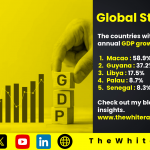The financial landscape of 2022 was a rollercoaster ride, with markets experiencing dramatic swings, inflation on the rise, and countries’ prosperity being significantly impacted. Let’s delve into the biggest winners and losers of financial prosperity in 2022.
Countries with the Biggest Increase in Prosperity
| Flag | Country | Increase in Prosperity |
|---|---|---|
| 🇧🇷 | Brazil | $1.1 trillion |
| 🇮🇳 | India | $0.675 trillion |
| 🇲🇽 | Mexico | $0.655 trillion |
| 🇷🇺 | Russia | $0.6 trillion |
Brazil: Brazil witnessed a remarkable increase in prosperity, amounting to $1.1 trillion. This surge was propelled by robust economic growth and soaring commodity prices.
India: India’s prosperity surged by $0.675 trillion, primarily fueled by strong domestic demand and surging exports.
Mexico: Mexico experienced a $0.655 trillion boost in prosperity, driven by a recovery in its manufacturing sector and robust remittances from the United States.
Russia: Despite facing ongoing sanctions from the West, Russia’s prosperity increased by $0.6 trillion.
Countries with the Biggest Financial Market Losses
| Flag | Country | Financial Market Losses |
|---|---|---|
| 🇦🇺 | Australia | $1 trillion |
| 🇨🇦 | Canada | $1.2 trillion |
| 🇨🇳 | China | $1.5 trillion |
| 🇯🇵 | Japan | $2.5 trillion |
| 🇺🇸 | United States | $5.9 trillion |
Australia: Australia’s financial markets incurred losses of $1 trillion due to a combination of factors, including rising interest rates, falling commodity prices, and the Ukraine war.
Canada: Similar to Australia, Canada’s financial markets suffered losses of $1.2 trillion, influenced by similar factors.
China: China faced substantial losses of $1.5 trillion in its financial markets, attributed to a regulatory crackdown on the technology sector and concerns about economic growth.
Japan: Japan’s financial markets took a significant hit, losing $2.5 trillion. This was primarily due to rising interest rates and the war in Ukraine.
United States: The United States experienced the most substantial financial market losses, totaling $5.9 trillion. Factors contributing to this include rising inflation, the Ukraine war, and concerns about the Federal Reserve’s ability to control inflation without causing a recession.
Behind the Numbers
The extreme market fluctuations in 2022 were influenced by several key factors:
- The War in Ukraine: The conflict in Ukraine caused energy prices to soar, adversely affecting economic growth and contributing to inflation.
- Rising Interest Rates: Central banks worldwide raised interest rates to combat inflation, which had repercussions on economic growth and asset values.
- The Ongoing COVID-19 Pandemic: The pandemic continued to disrupt global supply chains and impede economic growth.
The Outlook for 2023
The outlook for financial markets in 2023 remains uncertain. The ongoing Ukraine conflict may persist, further disrupting global supply chains and economic growth. Central banks are expected to continue raising interest rates, potentially weighing further on economic expansion. Nevertheless, some positive indicators, such as strong corporate earnings and increasing vaccination rates, offer hope for a more stable financial landscape.
In summary, 2022 proved to be a challenging year for financial markets, but amid the turbulence, there are glimmers of optimism suggesting that the worst may be behind us. 🌍💹 #FinancialProsperity #MarketAnalysis










